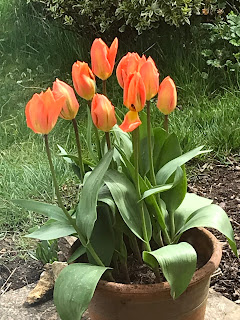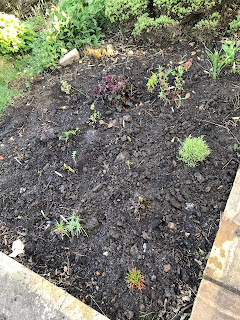With all the February/March pruning tasks (wisteria,
buddleja, apple tree) out of the way, despite the soggy weather (and occasional
hailstorm), I’ve been turning my attention and my loppers to other hacking back
jobs. A dry day (there haven’t been
many) on Easter Saturday was ideal for getting into the Forest.
My original idea for this area was to plant up a mini woodland glade, with small trees and shrubs, and a path running through it. As the shrubs (too many, too big, planted too close together) have grown, and been invaded by ivy, brambles and other unwanted plants, though, what I’ve ended up with is less a glade and more an impenetrable, Tolkein-esque forest, albeit on a very small scale. So I scrambled into my mini-Mirkwood with loppers and a saw and set to work.
The oldest plant in this space is a small tree, a purple-leaved
prunus which was in the garden when we arrived, over 30 years ago. It is showing its age, covered in lichen and,
less desirably, in ivy, and suckering prolifically at the base; I’ve tried in
the past to get the suckers out, but they are rooted too far below the
surface. It’s too early in the year to
prune it safely, so I’ve left it alone for the moment.
 |
| Lichen and ivy on the prunus |
Alongside I had planted a winter honeysuckle
(Lonicera purpusii), which has a spreading habit and has spread its arms much
wider than I expected; a philadelphus, which has never done well and which I’ve
been threatening to dig out for as long as I’ve been writing this blog, and
probably before that; a Viburnum x bodnantense ‘Dawn’, which was originally one
plant and now has somehow turned into three (large) shrubs; another small tree,
a Euonymus europaeus ‘Red Sentinel’; and a Viburnum tinus ‘Gwenllian’. (There was originally a magnolia as well,
which didn’t last long. Why did I think
that was a good idea?) Oh yes, and there’s
also a rose, Rosa ‘Old Blush China’, which I always forget about because it’s
now underneath the honeysuckle.
 |
| Viburnum tinus 'Gwenllian' (the healthy bit) |
The main problem, apart from the age of the plants, which
are becoming rather elderly, turned out to be the Viburnum tinus, planted at
the centre of things. Some people find
them foul-smelling, but I can’t say I’ve ever noticed. I have two V. tinus – there’s another at the
side of the house, donated by a friend who had no space for it – but
‘Gwenllian’ is the more attractive of the two; it has pink-tinged flowers in
winter, followed by shiny blue berries.
I’m hoping to keep it, but to cut it back to a more manageable
size. It has several large, spreading
branches, some of which have died back, and all of which were host to swathes
of ivy. Being squeezed into a too-small
area, it has shot upwards and out, across what was originally intended to be a
woodland path. This part of the plant is
flowering and berrying well, and, although it will have to go in due course,
I’ve left it for the time being, concentrating on removing the dead bits and
cutting back some of the spindly shoots struggling up towards the light. There is still more to be done here, but the
weather has turned wet again, leaving me with a large pile of dead wood to
dispose of and a lot more ivy to rip out!
 |
| This is meant to be a path ... |
Meanwhile, out in the less congested parts of the garden,
the daffodils are doing well, including ‘Jenny’ in the front garden, and last
year’s ‘Exotic Emperor’ tulips are flowering impressively in their pot.
 |
| Narcissus 'Jenny' |
 |
Tulip 'Exotic Emperor'
|
































